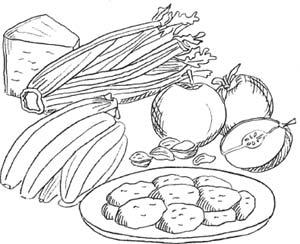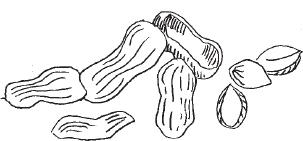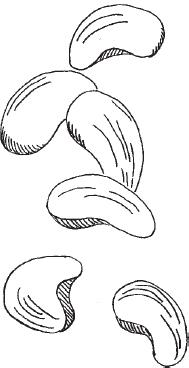Nourishing Traditions: The Cookbook That Challenges Politically Correct Nutrition and The... (141 page)
Authors: Sally Fallon,Pat Connolly,Phd. Mary G. Enig
Tags: #Non-Fiction, #Reference, #Science, #Health
In many countries around the world, lacto-fermented foods, or at least certain lacto-fermented foods, are valued for their medicinal properties. . .. In Europe during the 19th century, doctors prescribed sauerkraut for numerous diseases—for enlarged liver and spleen, hemorrhoids, constipation, nervous troubles and hysteria. In Germany and Poland sauerkraut juice and juice of fermented cucumbers are still used to treat enteritis.
The therapeutic value of yoghurt is well known, notably for the reestablishment of intestinal flora. . .. In India
idli
(lacto-fermented rice and lentils) is particularly recommended for children and people in a weakened condition;
dahi
(a fermented milk product similar to yoghurt) is recommended for dyspepsia, dysentery and various intestinal disorders. It is also recommended to stimulate the appetite and to increase vitality. In Mexico
pozol
(fermented corn) is used to counter diarrhea; it is also made into poultices to dress wounds. Mixed with water and honey, it is given to the sick to bring down fevers.
Pulque
, a fermented drink inherited from the Aztecs and made with cactus juice, is used to treat kidney infections and to stimulate lactation. In Nigeria
ogi
(lacto-fermented corn) is given to babies, to the sick and to convalescents; it also is valued for stimulating lactation. In Greece and Turkey
tarhanas
(mixture of wheat and fermented milk) is consumed in large quantities by nursing mothers, by infants when they are weaned, by the sick and the very old. Claude Aubert
Les Aliments Fermentes Traditionnels
INDIAN-STYLE PANCAKES
(Dosas)
Makes about 20
1 cup lentils
2 cups brown rice
warm filtered water
2 tablespoons whey
Whey and Cream Cheese
or lemon juice1 teaspoon salt
about
1
/
3
cup
clarified butter
Wash lentils and rice well and place in separate bowls. Cover each with warm water, add 1 tablespoon whey or lemon juice to each and leave overnight in a warm place. Drain each and process separately in a food processor with a little water until smooth. Mix lentils and rice together with salt and enough warm water to make a batter about the consistency of cream. Cover and leave another 24 hours in a warm place.
To cook, heat a heavy, cast-iron skillet and brush with clarified butter. Ladle about ¼ cup into pan and tip pan to spread batter. Cook about 5 minutes per side. (You may further thin batter with water to make a paper-thin dosa, but it takes some practice to turn these without tearing.) Keep warm in oven while preparing remaining dosas. Brush pan with butter between each pancake. Serve hot or warm with
curry sauce
,
yoghurt sauce
or
fruit chutney
.Variation: Indian-Style Coconut Pancakes
Place
2 cups finely grated fresh or dried coconut, 2 tablespoon coarsely chopped ginger, 2 small green chiles, coarsely chopped, 2 small onions, coarsely chopped, ½ teaspoon salt
and
1 bunch cilantro
in food processor and process to a paste. Blend into batter, along with additional water if necessary to achieve desired consistency, and proceed with recipe.Variation: Indian-Style Onion Pancakes
Saute
2 onions, very finely chopped
and
2 teaspoons mustard seeds in butter.
Stir into batter, along with additional water if necessary to achieve desired consistency, and proceed with recipe.
Food of the Indian
idli
type, acidified and leavened through fermentation by heterofermentative lactic acid bacteria, constitutes a very interesting group of cereal-based foods of considerable potential importance in the developing and also the developed world where it is largely unknown. Idli is closely related to sourdough bread of the Western world, but it does not depend upon wheat or rye as a source of protein to retain the carbon dioxide gas during leavening. Leavening is produced by bacterial rather than by yeast activity. The importance of idli lies in (1) its high degree of acceptability as a food in South India, (2) its protection against food poisoning and transmission of pathogenic organisms, because of its acidity, and (3) the fact that the idli fermentation can be used in many parts of the world using various combinations of cereal grains and legumes to produce acid, leavened bread or a pancake-like product. No wheat or rye flour is needed.
Idli and dosa. . .can be consume directly "out-of-hand" following steaming, or the cakes may be deliciously flavored with fried mustard seeds and chopped coriander leaves. The unflavored cakes are eaten with chutney and/or sambar, a thin spiced soup of dhal and vegetables. . .. These foods are an important source of protein and calories in the diet and nutrition of South Indians. Idli and dosa. . .constitute the breakfast of many South Indians, regardless of economic or social status. Because they are easily digested, they are often used as food for infants and invalids. Keith H. Steinkraus ed. p 131
Handbook of Indigenous Fermented Foods
Courtesy Marcel Dekker, Inc.

In an ideal world we would consume all our food at sit-down meals; nevertheless, snacks have their place in today's diet, especially for growing children and for those whose metabolisms require small frequent feedings. Wise parents will keep a variety of nutritious snacks on hand, but at the same time will see to it that they do not replace proper meals.
Many of our snacks call for nuts, such as almonds, pecans, cashews and peanuts, either plain, in mixes, or as a basis for nut butters and cookies. Nuts are an extremely nutritious food if properly prepared. Once again, the habits of traditional peoples should serve as a guide. They understood instinctively that nuts are best soaked or partially sprouted before eaten. This is because nuts contain numerous enzyme inhibitors that can put a real strain on the digestive mechanism if consumed in excess. Nuts are easier to digest, and their nutrients more readily available, if they are first soaked in salt water overnight, then dried in a warm oven. (You may also use a dehydrator.) This method imitates the Aztec practice of soaking pumpkin or squash seeds in brine and then letting them dry in the sun before eating them whole or grinding them into meal. Salt in soaking water activates enzymes that neutralize enzyme inhibitors. An excellent snack is crispy nuts with raw cheese.
Our cookie recipes feature nuts, butter or coconut oil, natural sweeteners and arrowroot or bulgur flour made from sprouted wheat. These recipes offer you the opportunity to discover the merits of coconut oil. Coconut oil is richer than butter in medium-chain fatty acids, which the body absorbs directly from the small intestine for quick energy. Research has shown that coconut oil, like butter, promotes normal brain development, is less likely to cause weight gain than polyunsaturated oils, contributes to strong bones and has anticarcinogenic and antimicrobial effects. (For arrowroot and unrefined coconut oil, See
Sources
.)
We have included a recipe for pizza—the perennial favorite—made with a yoghurt crust and fresh tomato sauce. All snacks feature whole, natural ingredients in contrast to empty calories—in the form of refined sweeteners, white flour and rancid and hydrogenated vegetable oils—that make up the vast majority of commercially produced snack foods. These empty snack foods, consumed in great quantities by our youth, have resulted in a generation of teenagers imbued with the vague feeling that they have been cheated—as indeed they have.
A popular "health food" snack we must warn you about is rice cakes, made from puffed or extruded rice. Although theoretically nutritious, because made from whole grains, they are grains that have been subjected to high heat and pressure to cause them to puff. Diets of puffed grains cause rapid death in test animals.
PEPITAS
(Crispy Pumpkin Seeds)
Makes 4 cups
4 cups raw, hulled pumpkin seeds
2 tablespoons sea salt
1 teaspoon cayenne pepper (optional)
filtered water
This recipe imitates the Aztec practice of soaking seeds in brine, then letting them dry in the hot sun. They ate pepitas whole or ground into meal.
Dissolve salt in water and add pumpkin seeds and optional cayenne. Leave in a warm place for at least 7 hours or overnight. Drain in a colander and spread on a stainless steel baking pan. Place in a warm oven (no more than 150 degrees) for about 12 hours or overnight, turning occasionally, until thoroughly dry and crisp. Store in an airtight container.
If you eat substantial quantities of raw pecans, walnuts, Brazil nuts, filberts or others, you have a choice of swallowing enzyme capsules with them to neutralize their enzyme inhibitors or first germinating the nuts and letting nature do the job through increased enzyme activity resulting from germination. . .. In the year 1918 or thereabouts, I was imbued with the idea of trying to avoid cooked food because of the potential destructiveness of heat. . .. I thought that raw meat was unsuited for the human diet and that the protein and fat of palatable raw tree nuts would take its place. . .after a period of about two months, during which I consumed liberal quantities of raw tree nuts of several kinds, I began experiencing an unpleasant heavy sensation in the abdomen and a feeling of extreme fullness and some nausea. The symptoms were pronounced enough to force my giving up this tasty diet. Almost anyone can eat several nuts without feeling any effect. But it is common knowledge that nuts "are heavy on the stomach" if consumed in substantial quantity. The enzyme inhibitors in seeds explain the mystery, but they were not identified until 1944. Edward Howell, MD
Food Enzymes for Health and Longevity
CRISPY PECANS
Makes 4 cups
4 cups pecan halves
2 teaspoons sea salt
filtered water
The buttery flavor of pecans is enhanced by soaking and slow oven drying. Mix pecans with salt and filtered water and leave in a warm place for at least 7 hours or overnight. Drain in a colander. Spread pecans on a stainless steel baking pan and place in a warm oven (no more than 150 degrees) for 12 to 24 hours, turning occasionally, until completely dry and crisp. Store in an airtight container. Great for school lunches!
Variation: Crispy Walnuts
Use
4 cups walnuts halves and pieces, preferably freshly shelled
instead of pecans. Store in an airtight container in the refrigerator.
Nuts are rich sources of natural oils, ranging in total fat content from 60% to 80% of calories. Almonds, pecans, cashews, macadamia nuts and peanuts have a high content of stable oleic acid. Thus, they do not go rancid easily and once prepared by soaking and dehydrating may be stored for many months at room temperature in an airtight container. Walnuts, on the other hand, contain large amounts of triple unsaturated linolenic acid and are much more susceptible to rancidity. They should always be stored in the refrigerator. SWF
HOLIDAY PECANS
Makes 4 cups
4 cups crispy pecan halves (
crispy pecans
)3 egg whites
pinch sea salt
½ cup maple syrup
1 tablespoon vanilla extract
Beat egg whites with salt in a clean bowl until stiff. Slowly beat in maple syrup and vanilla. Fold in pecans until well coated. Spread on two buttered, stainless steel baking pans and place in a warm oven (no more than 150 degrees) for several hours until the egg white coating hardens. Store in an airtight container in the refrigerator.
Pecans are the pride of the South. They grow on huge trees throughout the Mississippi River Valley, especially in Georgia, New Mexico and Texas. Pecan trees grow to 150 feet with trunks of 7 feet in diameter. Mature trees can produce up to 200 pounds of nuts per year.
Like all nuts, pecans contain enzyme inhibitors that can irritate the mouth and cause digestive problems. Native Americans understood instinctively that pecans had to be treated in some way before they were consumed. They ground the nuts and soaked them in water to make a nutritious milky drink, much as European farmers made a kind of milk from walnuts.
Pecans contain about 70 percent fat, most of it monounsaturated oleic acid. This stable oil protects pecans from rancidity and gives them good keeping qualities. Pecans contain calcium, iron, magnesium, phosphorus, potassium and selenium. They are an exceptionally rich source of manganese. Like all nuts from large trees whose roots extend far down into the earth, pecans are good sources of trace minerals. They contain B complex vitamins, carotenoids and vitamin C in small amounts.
Pecans will last about four months at room temperature. To keep them longer, store in refrigerator. SWF

CRISPY PEANUTS
Makes 4 cups
4 cups raw peanuts, preferably skinless
1 tablespoon sea salt
filtered water
Mix peanuts with salt and filtered water and leave in a warm place for at least 7 hours or overnight. Drain in a colander. Spread on a stainless steel baking pan and place in a warm oven (no more than 150 degrees) for 12 to 24 hours, turning occasionally, until completely dry and crisp. Store in an airtight container.
Variation: Crispy Pine Nuts
Use
4 cups pine nuts
instead of raw peanuts.
Variation: Crispy Hazelnuts
Use
4 cups skinless hazelnuts
in place of peanuts. (To peel hazelnuts, place on a cookie sheet and bake at 300 degrees until skins turn dark and begin to crack. Place hazelnuts in a kitchen towel and wrap up tightly. Hold towel-wrapped nuts in your hands and rub and squeeze for several minutes. Open up towel—most of the skins should have come off.)
CRISPY ALMONDS
Makes 4 cups
4 cups almonds, preferably skinless
1 tablespoon sea salt
filtered water
Skinless almonds will still sprout, indicating that the process of removing their skins has not destroyed the enzymes. (The skins are probably removed by a machine process.) Skinless almonds are easier to digest and more satisfactory in many recipes. However, you may also use almonds with the skins on.
Mix almonds with salt and filtered water and leave in a warm place for at least 7 hours or overnight. Drain in a colander. Spread on a stainless steel baking pan and place in a warm oven (no more than 150 degrees) for 12 to 24 hours, stirring occasionally, until completely dry and crisp. Store in an airtight container.
Variation: Crispy Almond Slivers
Use
4 cups slivered almonds
instead of whole almonds.
CRISPY CASHEWS
Makes 4 cups
4 cups "raw" cashews
1 tablespoon sea salt
filtered water
Some care must be taken in preparing cashews. They will become slimy and develop a disagreeable taste if allowed to soak too long or dry out too slowly, perhaps because they come to us not truly raw but having already undergone two separate heatings. You may dry them in a 200 to 250 degree oven—the enzymes have already been destroyed during processing.
Soak cashews in salt and filtered water for 6 hours (no longer). Drain in a colander. Spread on a stainless steel baking pan and place in a warm oven (about 200 degrees) for 12 to 24 hours, turning occasionally, until completely dry and crisp. Store in an airtight container. Great for school lunches!
The cashew nut comes from a pear-shaped fruit called the cashew apple. Curiously, the nut grows outside of the apple and hangs down so that it can be easily harvested. A native of Brazil, where natives make the apples into preserves or liqueur, the cashew also grows in India. About 90 percent of our domestic supply of cashews comes from India.
Cashews are rich in protein as well as magnesium, phosphorus and potassium. They contain less fat than most other nuts.
Cashews contain a toxic oil called cardol between the inner and outer shell. This is released by cracking the nuts and roasting them at 350 degrees. They are then cracked and roasted once again. These are then marketed as "raw" cashews.
We recommend soaking "raw" cashews in salt water and then lightly toasting them to make them more digestible. Unlike other nuts which benefit from an overnight soaking, "raw" cashews should be soaked no longer than 6 hours.
Always buy whole cashews rather than pieces as they are less likely to be stale. SWF
